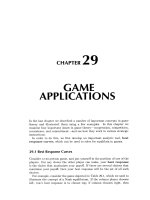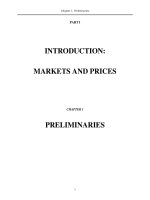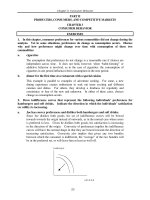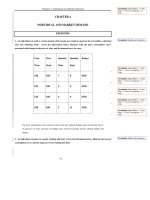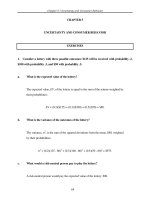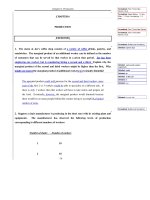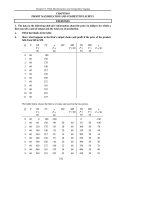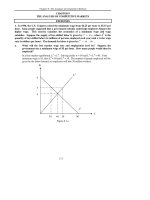Tài liệu Bài tập về Kinh tế vĩ mô bằng tiếng Anh - Chương 5 pdf
Bạn đang xem bản rút gọn của tài liệu. Xem và tải ngay bản đầy đủ của tài liệu tại đây (97.83 KB, 17 trang )
Chapter 5: Uncertainty and Consumer Behavior
64
CHAPTER 5
UNCERTAINTY AND CONSUMER BEHAVIOR
EXERCISES
1. Consider a lottery with three possible outcomes: $125 will be received with probability .2,
$100 with probability .3, and $50 with probability .5.
a. What is the expected value of the lottery?
The expected value, EV, of the lottery is equal to the sum of the returns weighted by
their probabilities:
EV = (0.2)($125) + (0.3)($100) + (0.5)($50) = $80.
b. What is the variance of the outcomes of the lottery?
The variance, σ
2
, is the sum of the squared deviations from the mean, $80, weighted
by their probabilities:
σ
2
= (0.2)(125 - 80)
2
+ (0.3)(100 - 80)
2
+ (0.5)(50 - 80)
2
= $975.
c. What would a risk-neutral person pay to play the lottery?
A risk-neutral person would pay the expected value of the lottery: $80.
Chapter 5: Uncertainty and Consumer Behavior
65
2. Suppose you have invested in a new computer company whose profitability depends on
(1) whether the U.S. Congress passes a tariff that raises the cost of Japanese computers and
(2) whether the U.S. economy grows slowly or quickly. What are the four mutually
exclusive states of the world that you should be concerned about?
The four mutually exclusive states may be represented as:
Congress passes tariff Congress does not pass tariff
Slow growth rate State 1:
Slow growth with tariff
State 2:
Slow growth without tariff
Fast growth rate State 3:
Fast growth with tariff
State 4:
Fast growth without tariff
3. Richard is deciding whether to buy a state lottery ticket. Each ticket costs $1, and the
probability of the following winning payoffs is given as follows:
Probability Return
025 $1 00
020 $2 00
005 $7 50
a. What is the expected value of Richard’s payoff if he buys a lottery ticket? What is
the variance?
Chapter 5: Uncertainty and Consumer Behavior
The expected value of the lottery is equal to the sum of the returns weighted by their
probabilities:
EV = (0.5)(0) + (0.25)($1.00) + (0.2)($2.00) + (0.05)($7.50) = $1.025
The variance is the sum of the squared deviation from the mean, $1.025, weighted
by their probabilities:
σ
2
= (0.5)(0 - 1.025)
2
+ (0.25)(1 - 1.025)
2
+ (0.2)(2 - 1.025)
2
+ (0.05)(7.5 - 1.025)
2
, or
σ
2
= $2.812.
b. Richard’s nickname is “No-risk Rick.” He is an extremely risk-averse individual.
Would he buy the ticket?
An extremely risk-averse individual will probably not buy the ticket, even though
the expected outcome is higher than the price, $1.025 > $1.00. The difference in
the expected return is not enough to compensate Rick for the risk. For example, if
his wealth is $10 and he buys a $1.00 ticket, he would have $9.00, $10.00, $11.00,
and $16.50, respectively, under the four possible outcomes. Let us assume that his
utility function is U = W
0.5
, where W is his wealth. Then his expected utility is:
EU = 0.5
()
9
0.5
()
+ 0.25
()
10
0.5
( )
+ 0.2
( )
11
0.5
( )
+ 0.05
( )
16.5
0.5
( )
= 3.157.
This is less than 3.162, which is the utility associated with not buying the ticket
(U(10) = 10
0.5
= 3.162). He would prefer the sure thing, i.e., $10.
c. Suppose Richard was offered insurance against losing any money. If he buys 1,000
lottery tickets, how much would he be willing to pay to insure his gamble?
66
Chapter 5: Uncertainty and Consumer Behavior
If Richard buys 1,000 tickets, it is likely that he will have $1,025 minus the $1,000
he paid, or $25. He would not buy any insurance, as the expected return, $1,025,
is greater than the cost, $1,000. He has insured himself by buying a large number
of tickets. Given that Richard is risk averse though, he may still want to buy
insurance. The amount he would be willing to pay is equal to the risk premium,
which is the amount of money that Richard would pay to avoid the risk. See figure
5.4 in the text. To calculate the risk premium, you need to know the utility
function. If the utility function is U = W
0.5
, then his expected utility from the 1,000
lottery tickets is
EU = 0.5
()
0
0.5
()
+ 0.25
()
1000
0.5
()
+ 0.2
( )
2000
0.5
( )
+ 0.05
( )
7500
0.5
( )
= 21.18.
This is less than the utility he would get from keeping his $1000 which is
U=1000
0.5
=31.62. To find the risk premium, find the level of income that would
guarantee him a utility of 21.18, which is $448.59. This means he would pay
$1000-$448.59=$551.41 to insure his gamble.
d. In the long run, given the price of the lottery ticket and the probability/return table,
what do you think the state would do about the lottery?
In the long run, the state lottery will be bankrupt! Given the price of the ticket and
the probabilities, the lottery is a money loser. The state must either raise the price
of a ticket or lower the probability of positive payoffs.
4. Suppose an investor is concerned about a business choice in which there are three
prospects, whose probability and returns are given below:
Probability Return
0.4 $100
67
Chapter 5: Uncertainty and Consumer Behavior
68
0.3 30
0.3 -30
What is the expected value of the uncertain investment? What is the variance?
The expected value of the return on this investment is
EV = (0.4)(100) + (0.3)(30) + (0.3)(-30) = $40.
The variance is
σ
2
= (0.4)(100 - 40)
2
+ (0.3)(30 - 40)
2
+ (0.3)(-30 - 40)
2
= $2,940.
5. You are an insurance agent who has to write a policy for a new client named Sam. His
company, Society for Creative Alternatives to Mayonnaise (SCAM), is working on a low-fat,
low-cholesterol mayonnaise substitute for the sandwich condiment industry. The sandwich
industry will pay top dollar to whoever invents such a mayonnaise substitute first. Sam’s
SCAM seems like a very risky proposition to you. You have calculated his possible returns
table as follows.
Probability Return
.999 -$1,000,000 (he fails)
.001 $1,000,000,000 (he succeeds and
sells the formula)
Chapter 5: Uncertainty and Consumer Behavior
69
a. What is the expected return of his project? What is the variance?
The expected return, ER, of the investment is
ER = (0.999)(-1,000,000) + (0.001)(1,000,000,000) = $1,000.
The variance is
σ
2
= (0.999)(-1,000,000 - 1,000)
2
+ (0.001)(1,000,000,000 - 1,000)
2
, or
σ
2
= 1,000,998,999,000,000.
b. What is the most Sam is willing to pay for insurance? Assume Sam is risk neutral.
Because Sam is risk neutral and because the expected outcome is $1,000, Sam is
unwilling to buy insurance.
c. Suppose you found out that the Japanese are on the verge of introducing their own
mayonnaise substitute next month. Sam does not know this and has just turned
down your final offer of $1,000 for the insurance. Assume that Sam tells you SCAM
is only six months away from perfecting its mayonnaise substitute and that you know
what you know about the Japanese. Would you raise or lower your policy premium
on any subsequent proposal to Sam? Based on his information, would Sam accept?
The entry of the Japanese lowers Sam’s probability of a high payoff. For example,
assume that the probability of the billion dollar payoff is lowered to zero. Then the
expected outcome is:
